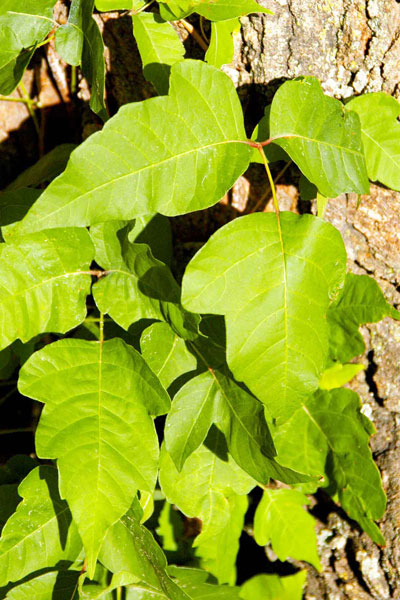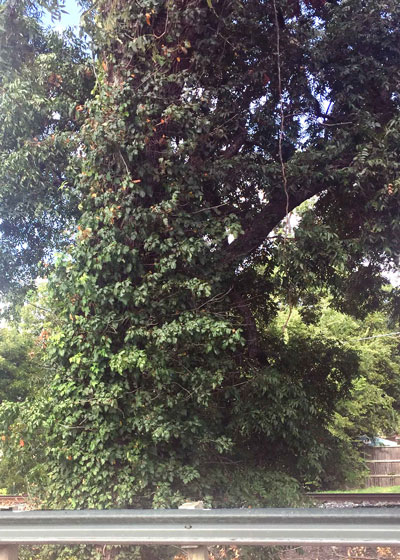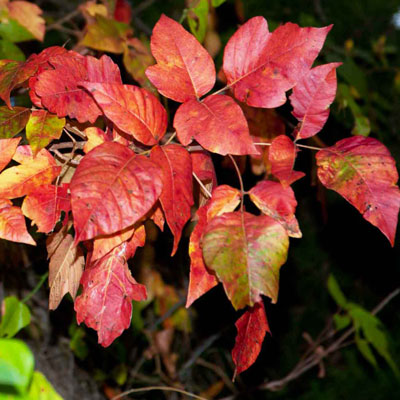Question of the Week 2: August 10, 2017
“Neil, how can I identify and control poison ivy?”

Photo: You’re looking for a plant with three leaflets per leaf (“Leaves of three, let it be…”). Toward the bottom you have the harmless five-leaflet leaves of Virginia creeper. In the upper right you have the ones that can set people’s skin allergies ablaze: poison ivy.
Here are the facts you must remember in dealing with poison ivy:
• Every person is potentially susceptible to the allergic rashes of this plant. Some of us are much more susceptible than others. But in moments of weakened immunity (coming down with a cold, as one possible example), anyone can fall victim.
• Every part of the poison ivy plant (roots, stems, leaves and fruit) contains the oils that cause the allergic reaction. Therefore, coming into contact with any part of the plant, or even making contact with tools or clothes that have made contact with a part of the plant can lead to allergic reaction. Breathing smoke as you burn poison ivy brush can cause a reaction. Deal with poison ivy with great respect and care.
• In Texas we basically have only poison ivy. Poison sumac (actually a close relative of poison ivy) is found only in a few counties of Deep East Texas) and poison oak is not found in Texas.
• Poison ivy takes the form of a vine growing up fences and tree trunks, but out in the open it will cover the ground, standing erect to several feet. Just keep your eyes open for those three-parted leaflets.

Photo: You can easily see the three leaflets of the poison ivy leaf in this photo.
Controlling poison ivy in open areas…
There are several approaches depending on where the poison ivy is growing.
• When you have open access to a stand of poison ivy in a field or in turf, you can apply one of the broadleafed weedkillers containing 2,4-D. These work best on tender new growth in the spring. You will still get some measure of control now, but you may have to re-treat next May.
• When the poison ivy is growing in a shrub bed or groundcover, you will have to be much more selective. It may involve “painting” the herbicide on with a foam rubber paintbrush. If you can see where the vine comes out of the ground, sever it there and leave the top growth in place to dry and die. You can pull it out with a hoe or rake once it becomes brittle, and you can reach in to apply the broadleafed weedkiller to the sprouts as they re-emerge from the stump. Or, if possible, pop the stump and root mass out with a long-handled shovel. Just don’t touch it.

Photo: Massive poison ivy plant completely shrouds pecan trunk on Highway 78 north of Garland. Pity any arborist who gets to work on this tree!
• When poison ivy is attached to a tree trunk and growing up into its canopy (as is often the case), use a long-handled axe to sever it near the ground. Make a second cut a foot or so higher up, then use the axe to macerate the stump. Pour a broadleafed weedkiller onto the pulverized wood of the stump at full strength. Be sure it doesn’t run off onto the ground. Let it soak into the wood slowly so it will be taken down into the roots. With a little luck it will not start sprouting again.
Wear disposable gloves, long pants and a long-sleeved shirt while you’re doing all this so you won’t get splatters of oil onto your skin. Wash the clothes and take a hot shower immediately once you are finished.
Leave all the old stems in the top of the tree. They will dry and release their hold gradually, then fall in pieces to the ground. You’ll be able to gather them with a rake or shovel and send them off to the landfill.
• Once you have rid your landscape and garden of the worst of the poison ivy you’ll have very few problems thereafter. You’ll see occasional seedlings, but you’ll soon learn to recognize them. They’re easily removed with a quick flick of the hoe.

Photo: And they say we have no fall color here in Texas! Untrue. Look how beautiful poison ivy can be as cool weather arrives in November. It’s probably not reason to keep it around, but it’s always nice to end with a smile.
